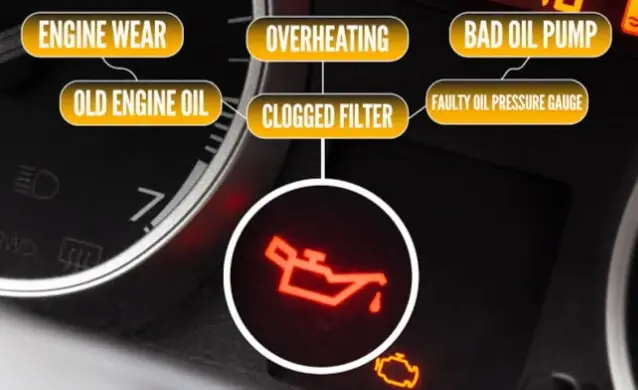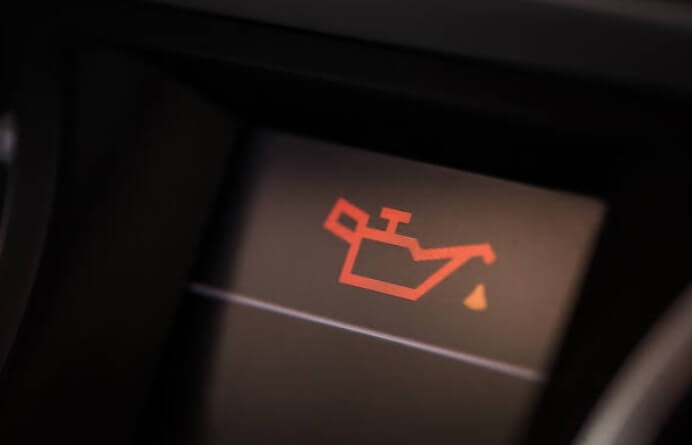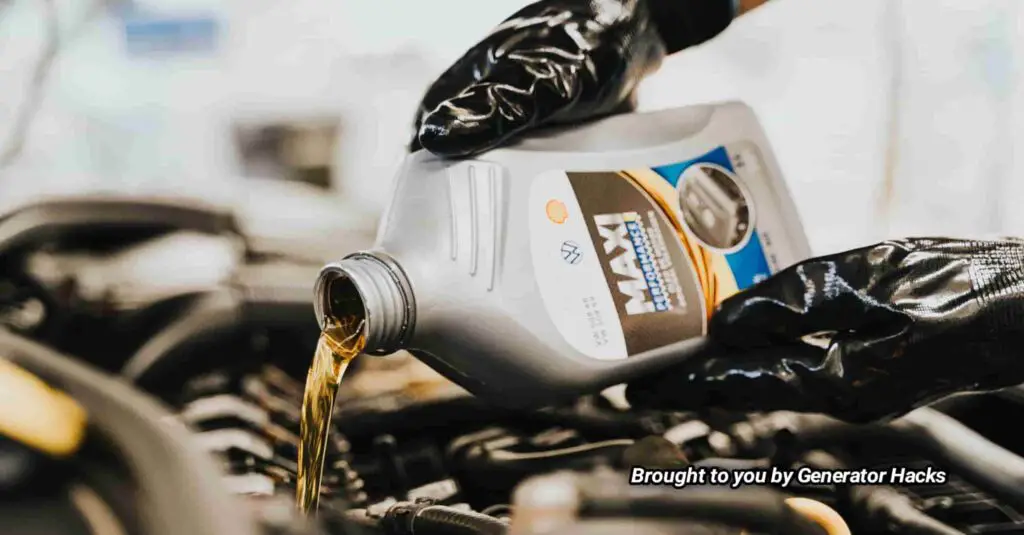As an Amazon Associate, we earn from qualifying purchases. This does not affect the price you pay or the quality of the products you buy. For more information, please read the full affiliate disclosure here.
Have you ever experienced the frustrating situation where your oil light comes on but the oil level is full? You might wonder what is wrong with your engine and how to fix it. Is it a serious problem that could damage your engine or just a minor glitch that can be easily resolved?
The oil light is a warning indicator that tells you when the oil pressure in your engine is too low.
Low oil pressure means that the oil is not flowing properly through the engine, which can cause overheating, friction, and wear. If you ignore the oil light, you could end up with a costly engine repair or even a total engine failure.
However, sometimes the oil light comes on even when the oil level is full. This could be due to various reasons, such as a faulty oil pressure sensor, a bad oil pump, a clogged oil filter, or a leak in the oil system.
In this blog post, we will explain the common causes of the oil light coming on when oil is full and how to diagnose and fix them. We will also give you some tips on how to prevent this problem from happening again.
How to Diagnose the Oil Light Problem

The first thing you should do when the oil light comes on but the oil is full is to check the oil level and condition. To do this, you will need a clean cloth and a dipstick, which is a metal rod that measures the oil level in the engine.
Here are the steps to follow:
- Turn off the engine and wait for a few minutes to let the oil settle.
- Locate the dipstick under the hood of your engine. It usually has a yellow or orange handle with an oil can symbol on it.
- Pull out the dipstick and wipe it with the cloth.
- Insert the dipstick back into the engine and pull it out again.
- Look at the tip of the dipstick and see where the oil level is. It should be between the two marks or holes that indicate the minimum and maximum oil levels.
- Also, check the color and consistency of the oil. It should be brown or black and smooth, not milky, gritty, or sludgy.
If the oil level is low, you need to add more oil to the engine. Make sure you use the right type and grade of oil for your engine, as specified in the owner’s manual. Do not overfill the engine with oil, as this can also cause problems.
If the oil level is normal but the oil is dirty or contaminated, you need to change the oil and the oil filter as soon as possible. Dirty oil can clog the oil passages and reduce the oil pressure in the engine.
If the oil level and condition are fine, then the problem is likely caused by something else. You will need to perform further tests to find out the exact cause of the oil light problem.
Some of the possible tests are:
1. Check the oil pressure sensor.
The oil pressure sensor is a device that measures the oil pressure in the engine and sends a signal to the oil light. If the sensor is faulty, it can give a false reading and trigger the oil light. You can test the sensor by using a multimeter or an oil pressure gauge. If the sensor is defective, you need to replace it with a new one.
2. Check the oil pump.
The oil pump is a device that pumps the oil from the oil pan to the engine. If the pump is worn out or damaged, it can fail to deliver enough oil to the engine, resulting in low oil pressure and an oil light. You can test the pump by measuring the oil pressure at different engine speeds. If the pump is faulty, you need to replace it with a new one.
3. Check the oil filter.
The oil filter is a device that filters the oil and removes any dirt, debris, or metal particles from it. If the filter is clogged or blocked, it can restrict the oil flow and cause low oil pressure and the oil light. You can test the filter by removing it and inspecting it for any signs of damage or contamination. If the filter is dirty or damaged, you need to replace it with a new one.
4. Check the oil system for leaks.
Leaks in the oil system can cause the oil to escape from the engine and reduce the oil pressure and the oil level. You can check for leaks by looking for any signs of oil stains, drips, or puddles under your car. You can also use a UV dye and a black light to detect any leaks in the oil system. If you find any leaks, you need to repair them as soon as possible.
How to Fix the Oil Light Problem
Once you have diagnosed the cause of the oil light problem, you need to fix it as soon as possible. Depending on the severity of the problem, you may be able to fix it yourself, or you may need to take your car to a professional mechanic.
Here are some general guidelines on how to fix the oil light problem:
1. If the problem is caused by a low oil level, you need to add more oil to the engine. Make sure you use the right type and grade of oil for your engine, as specified in the owner’s manual. Do not overfill the engine with oil, as this can also cause problems.
2. If the problem is caused by dirty or contaminated oil, you need to change the oil and the oil filter as soon as possible. Dirty oil can clog the oil passages and reduce the oil pressure in the engine. You can change the oil and the oil filter yourself or take it to a service station. You will need a wrench, a drain pan, a new oil filter, and new oil.
Here are the steps to follow:
- Park your engine on a level surface and turn it off. Wait for a few minutes to let the oil cool down.
- Locate the oil drain plug under the engine. It is usually a bolt or a nut that is attached to the oil pan. Place the drain pan under the plug and loosen it with the wrench. Be careful not to burn yourself with the hot oil. Let the oil drain completely.
- Locate the oil filter under the hood of your engine. It is usually a cylindrical metal or plastic device that is attached to the engine. Unscrew the oil filter and remove it. Some oil may spill out, so be prepared to catch it with the drain pan. Dispose of the old oil filter properly.
- Install the new oil filter by screwing it onto the engine. Make sure it is tight and secure. Do not over-tighten it, as this can damage the filter or the engine.
- Replace the oil drain plug and tighten it with the wrench. Do not over-tighten it, as this can damage the plug or the oil pan.
- Fill the engine with new oil. Use a funnel to avoid spilling. Check the owner’s manual for the correct amount and type of oil for your car. Do not overfill the engine with oil, as this can cause problems.
- Start the engine and let it run for a few minutes. Check the oil level again with the dipstick and adjust if necessary. Check for any leaks or signs of trouble. Turn off the engine and dispose of the used oil and oil filter properly.
3. If the problem is caused by a faulty oil pressure sensor, you need to replace it with a new one. The oil pressure sensor is a device that measures the oil pressure in the engine and sends a signal to the oil light. If the sensor is faulty, it can give a false reading and trigger the oil light. You can replace the oil pressure sensor yourself or take it to a mechanic. You will need a socket wrench, a new oil pressure sensor, and some thread sealant.
Here are the steps to follow:
- Locate the oil pressure sensor under the hood of your engine. It is usually a small metal or plastic device that is attached to the engine block or the oil filter housing. It has a wire connector that connects it to the electrical system.
- Disconnect the wire connector from the oil pressure sensor. Be careful not to damage the wire or the connector.
- Unscrew the oil pressure sensor from the engine or the oil filter housing. Some oil may spill out, so be prepared to catch it with a rag or a drain pan. Dispose of the old oil pressure sensor properly.
- Apply some thread sealant to the threads of the new oil pressure sensor. This will prevent any oil leaks or air bubbles from affecting the sensor’s performance.
- Screw the new oil pressure sensor into the engine or the oil filter housing. Make sure it is tight and secure. Do not over-tighten it, as this can damage the sensor or the engine.
- Reconnect the wire connector to the oil pressure sensor. Make sure it is firmly attached and not loose or damaged.
- Start the engine and check if the oil light is off. If the oil light is still on, there may be another problem with the oil system or the electrical system. You may need to take it to a mechanic for further diagnosis and repair.
4. If the problem is caused by a bad oil pump, you need to replace it with a new one. The oil pump is a device that pumps the oil from the oil pan to the engine. If the pump is worn out or damaged, it can fail to deliver enough oil to the engine, resulting in low oil pressure and an oil light.
Replacing the oil pump is a complex and labor-intensive task that requires special tools and skills. You should not attempt to replace the oil pump yourself unless you are an experienced and qualified mechanic. You should take it to a professional mechanic for this repair. The cost of replacing the oil pump may vary depending on the make and model of your engine, but it is usually expensive.
5. If the problem is caused by a clogged oil filter, you need to replace it with a new one. The oil filter is a device that filters the oil and removes any dirt, debris, or metal particles from it. If the filter is clogged or blocked, it can restrict the oil flow and cause low oil pressure and the oil light.
Replacing the oil filter is a simple and inexpensive task that you can do yourself or take to a service station. You will need a wrench, a drain pan, a new oil filter, and some oil. The steps to replace the oil filter are the same as the steps to change the oil and the oil filter, as described above.
6. If the problem is caused by a leak in the oil system, you need to repair it as soon as possible. Leaks in the oil system can cause the oil to escape from the engine and reduce the oil pressure and the oil level. You can check for leaks by looking for any signs of oil stains, drips, or puddles under your car. You can also use a UV dye and a black light to detect any leaks in the oil system. If you find any leaks, you need to repair them as soon as possible.
The type and location of the leak will determine the difficulty and cost of the repair. Some common sources of oil leaks are the oil pan gasket, the oil filter gasket, the oil pressure sensor gasket, the oil cooler lines, the valve cover gaskets, the camshaft seals, the crankshaft seals, and the head gasket. You can try to fix some of these leaks yourself with some sealant or gasket maker, but some of them may require professional help. You should consult a mechanic for advice on how to fix the oil leak problem.
How to Prevent the Oil Light Problem

The best way to prevent the oil light problem is to maintain your car regularly and follow the recommended oil change intervals. By doing this, you can ensure that your engine has enough clean oil to lubricate and cool the moving parts. You can also avoid any potential damage or wear that could cause the oil system to malfunction.
Here are some tips on how to prevent the oil light problem:
1. Check the oil level and condition regularly.
You should check the oil level and condition at least once a month or before any long trip. You can use the dipstick method as described above to check the oil level and condition. If the oil level is low, add more oil to the engine. If the oil is dirty or contaminated, change the oil and the oil filter as soon as possible.
2. Change the oil and the oil filter regularly.
You should change the oil and the oil filter according to the manufacturer’s specifications, which are usually based on the mileage or the time interval. You can find the recommended oil change intervals in the owner’s manual for your engine. You can also use an oil life monitor system, if your engine has one, to tell you when to change the oil and the oil filter. Changing the oil and the oil filter regularly can prevent the oil from getting dirty, sludgy, or diluted, which can affect the oil pressure and the oil light.
3. Use the right type and grade of oil for your car.
You should use the type and grade of oil that is suitable for your engine, climate, and driving conditions. You can find the recommended type and grade of oil in the owner’s manual for your engine. Using the right type and grade of oil can ensure that the oil has the proper viscosity and performance to protect your engine and prevent the oil light problem.
4. Inspect the oil system for any signs of damage or leaks.
You should inspect the oil system for any signs of damage or leaks at least once a year or whenever you change the oil and the oil filter. You can look for any cracks, corrosion, or wear on the oil pan, the oil pump, the oil filter, the oil pressure sensor, the oil cooler lines, and the oil gaskets and seals. You can also check for any oil stains, drips, or puddles under your car. If you find any signs of damage or leaks, you should repair them as soon as possible to prevent the oil light problem.
5. Avoid running your engine with low oil pressure or a low oil level.
You should avoid running your engine with low oil pressure or low oil level, as this can damage your engine and cause the oil light problem. If the oil light comes on while you are running it, you should turn off the engine as soon as possible. You should not run it until you have fixed the problem or taken it to a mechanic. Running your engine with low oil pressure or a low oil level can cause overheating, friction, and wear, which can lead to a costly engine repair or a total engine failure.
Final Thoughts
In this blog post, we have discussed the common causes, diagnosis, and solutions for the oil light problem. We have learned that the oil light is a warning indicator that tells us when the oil pressure in the engine is too low. Low oil pressure can damage the engine and cause a costly repair or a total engine failure. Therefore, you should not ignore the oil light and take action as soon as possible.
Stay Connected with Us!
Follow us on Facebook and Twitter for the latest updates on staying safe online. Don't forget to subscribe for more tips directly in your inbox!
Follow on Facebook Follow on X Follow on Pinterest Join Our Private Facebook Group

